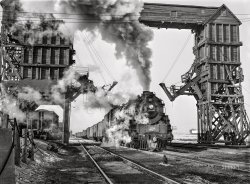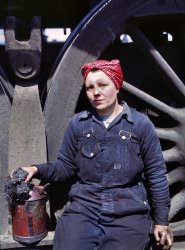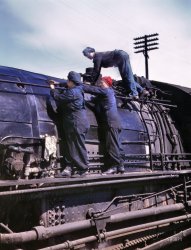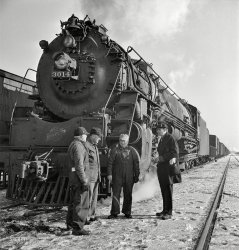
MAY CONTAIN NUTS

Search Shorpy
SHORPY ART

Framed or unframed, desk size to sofa size, printed by us in Arizona and Alabama since 2007. Explore now.
Join and Share
Ad-Free Shorpy
Shorpy is funded by you. Patreon contributors get an ad-free experience.
Learn more.

Recent comments
- Baldwin 62303
- Baldwin VO-1000
- Cold
- No expense spared
- Tough Guys
- Lost in Toyland
- And without gloves
- If I were a blindfolded time traveler
- Smoke Consumer Also Cooks
- Oh that stove!
- Possibly still there?
- What?!?
- $100 Reward
- Freeze Frame
- Texas Flyer wanted
- Just a Year Too Soon
- WWII -- Replacing men with women at the railroad crossing.
- Yes, Icing
- You kids drive me nuts!
- NOT An Easy Job
- I wonder
- Just add window boxes
- Icing Platform?
- Indiana Harbor Belt abides
- Freezing haze
- Corrections (for those who care)
- C&NW at Nelson
- Fallen Flags
- A dangerous job made worse
- Water Stop
Member Photos
The Shorpy
Print Emporium
Print Emporium
Search Shorpy
Search results -- 30 results per page
- Feed Me: 1943
- January 1943. "Nelson, Illinois. Chicago and North Western Railroad freight en route from Clinton, Iowa, to Chicago. Stopping for coal and water to give passenger trains ... diesels that run under it today don't stop (though some may toot in tribute).
Never ceases to amaze me. The powerhouse that ... Posted by Dave - 04/12/2024 - 2:49pm -

- Marcella Hart: 1943
- April 1943. Clinton, Iowa. "Mrs. Marcella Hart, mother of three, employed as a wiper at the ... the running boards to remove accumulations of cinders. May have even hosed down the deck of the cab during this busy time, although ... Posted by Dave - 08/30/2012 - 4:43pm -

- On Top of Old Steamy: 1943
- Clinton, Iowa. April 1943. "Chicago & North Western Railroad. Women wipers ... are so great! I don't know what it is, the colors may not be exactly accurate, but there's just something about them that grabs ... Posted by Dave - 08/30/2012 - 4:47pm -

- Women Wipers: 1943
- May 1943. Clinton, Iowa. " Women wipers of the Chicago & North Western Railroad ... Posted by Dave - 02/02/2014 - 3:33pm -
![Women Wipers: 1943 May 1943. Clinton, Iowa. "Women wipers of the Chicago & North Western Railroad going out to work on an engine at the roundhouse." Medium-format negative by Jack Delano for the Office of War Information. View full size.
PerspectiveThis really gives the viewer an idea of just how monstrously big that engine was!
TerrificJust terrific!
More Big Boys!As this shows up while Union Pacific 4014 is in transit to Cheyenne Wyoming for restoration, it would be nice to see more photos of the Big Boys in their heyday - and more of the Women Wipers too!
[Click the link in the caption. - Dave]
Not to diminish the size... of a steam locomotive, but the women are farther away from the front of the locomotive than it seems; a man standing beside that steam cylinder would almost be as tall as the cylinder. Steam locomotives were large indeed.
(The Gallery, Jack Delano, Railroads)](https://www.shorpy.com/files/images/SHORPY_8d29250u.thumbnail.jpg)
- Window Seat: 1943
- May 1943. "Clinton, Iowa. Women wipers of the Chicago & North Western cleaning one of ... Posted by Dave - 08/31/2016 - 12:44am -
![Window Seat: 1943 May 1943. "Clinton, Iowa. Women wipers of the Chicago & North Western cleaning one of the giant freight locomotives." Medium-format negative by Jack Delano for the Office of War Information. View full size.
C&NW engineThis was a so-called "Northern" steam engine, with a 4-8-4 wheel arrangement. Another photo:
http://abpr.railfan.net/july98/07-06-98/cxnw001.jpg
A Twofer!A locomotive and a caboose, in the same picture.
Her official RR job title - WIPERReally, look it up. Railroader's know.
[Do they know when to use an apostrophe? - Dave]
Comment envyLove the caboose comment! It only took me a second to get it
(The Gallery, Jack Delano, Railroads)](https://www.shorpy.com/files/images/SHORPY-8d29254a.thumbnail.jpg)
- Behemoth: 1943
- January 1943. "Freight operations on the Chicago & North Western between Chicago and Clinton, Iowa. The crew, with exception of the fireman, chat while waiting for ... rebuilt on February 11, 1948, as Class H-1 and retired on May 13, 1953.
That's that hat The guy second from left is wearing ... Posted by Dave - 12/10/2014 - 9:40am -
























